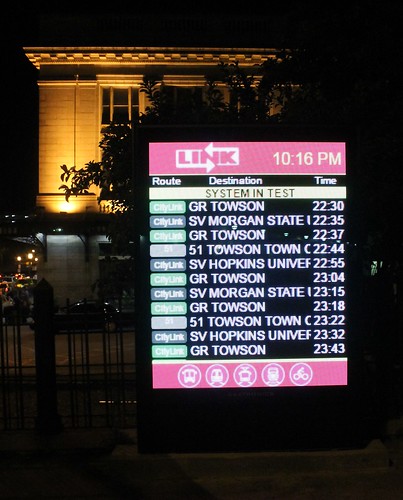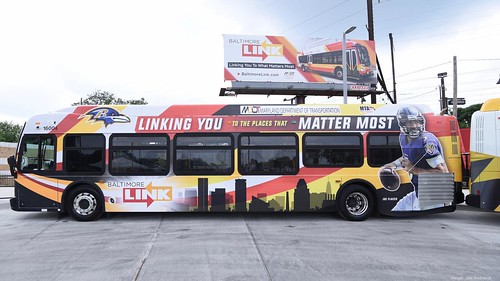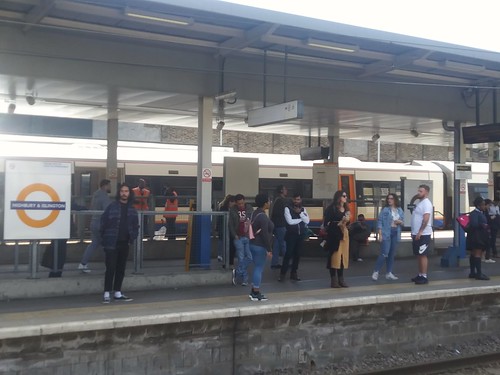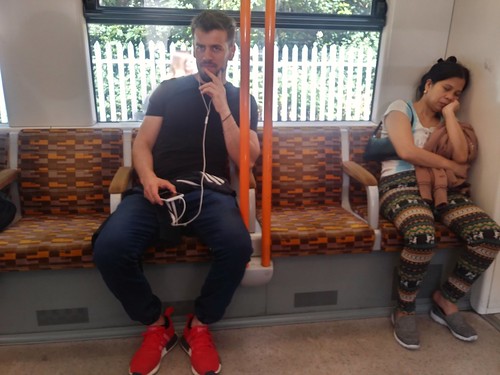BaltimoreLink bus system redesign, one year later
 The Baltimore Sun has a long piece, "One year of BaltimoreLink bus system: Ridership bounces back, reliability still falls short," evaluating the quantum scale changes to the Baltimore-area bus system one year later.
The Baltimore Sun has a long piece, "One year of BaltimoreLink bus system: Ridership bounces back, reliability still falls short," evaluating the quantum scale changes to the Baltimore-area bus system one year later.For many, the changes have lengthened trip times.
The reorganization was organized into what I term primary and secondary transit subnetworks.
-- Metropolitan Mass Transit Planning: Towards a Hierarchical and Conceptual Framework
The primary network is CityLink--color coded high frequency routes offering 24 hour service; complemented by a secondary network of neighborhood-based routes called Local Links, connecting neighborhoods to multiple CityLink services.
Note that during the Ehrlich Administration MTA created a network of limited stop faster routes called the QuickBus, which was the genesis of the new CityLink network, although focused on Baltimore City as opposed to longer city-suburban routes, like the QuickBus 48 route on York Road to Towson.
 According to the launch website, the system has added bus traffic signal prioritization on some routes, dedicated busways on some streets, better facilities, improvements in signage and real-time schedule displays, and connections to a richer set of "last mile connections" like bike share and car share.
According to the launch website, the system has added bus traffic signal prioritization on some routes, dedicated busways on some streets, better facilities, improvements in signage and real-time schedule displays, and connections to a richer set of "last mile connections" like bike share and car share.The changes came with bus livery redesign, new logos, and cross-marketing of the new system on light rail and subway cars.
Immediately after the changes, ridership dropped by almost 25%. Ridership returned to the buses over time and now it's 1% fewer riders than before the change.
Given that overall transit ridership is down 5% nationally, attributed to the rise in ride hailing services as well as cheap gasoline, maybe that's a victory.
It's hard to tell if the changes have made for a better transit system.

BaltimoreLink launched in June 2017 with a ribbon cutting ceremony at the new West Baltimore transfer center on Smallwood Street. Joe Andrucyk/Maryland Government.
Given that a lot of these massive overhauls of route structures for transit systems don't seem to result in significant ridership gains (see the January 2018 entry, "Improving bus service overall vs. reversing falling Metrobus ridership"), I wonder if we are focusing on the wrong things.
But what are the right things?
I have to acknowledge that maybe repositioning and rebranding bus service as premium, by switching to double deck buses, might not be enough. Although in London and other UK cities it works just fine, and more people ride buses in London on a daily basis than the entire railroad system in the UK.
-- "Marking bus service sexy and more equitable," 2012
-- Will buses ever be cool? Boston versus the Raleigh-Durham's GoTransit Model," 2017
The two main points of the first entry are:
1. bus service can be repositioned as a premium service by using double deck buses, which are seen as cool.
2. Introducing new buses and repositioning bus transit needs to be complemented with a series of other improvements to the provision of the service--I outlined eight categories of improvements (which is why the entry is way too long).
• Improve bus transit waiting environments
• Improve bus transit marketing
• Create a priority bus lane network in the core of the city
• Add Night Owl bus service along subway lines during the hours that the subway service doesn't run
• Improve wayfinding and transit information
• Augment on-board bus announcements and information on schedules, signage, etc., with landmark and destination information
• Create "Mobility" stores as part of transportation demand management programming
• Incorporate neighborhood history, public art elements, and transportation history interpretation into bus shelters
But MTA has incorporated many of these improvements into the BaltimoreLink program.
I think another point is pricing and other incentives. For example, in Columbus, Ohio they are introducing free transit passes to downtown workers as a transportation demand management measure ("Downtown Columbus parking issues getting partial fix as workers getting free COTA passes," Columbus Business First). That would get more choice riders onto buses.
But it's not like MTA doesn't provide a number of incentive programs for discounted transit passes, such as to colleges and employers. And the cost of a "day pass" to ride area transit (bus, subway, light rail) is cheap, $4.20/day.
Although to increase ridership but not farebox revenue, they could introduce "capping," so that low income riders paying daily for a day pass would stop paying daily once they've reached a payment equal to a monthly pass ($72).
London has capping and Edmonton is thinking about it ("Thinking systematically about bus transit service improvements: spurred by Columbia SC, Edmonton AB, and Baltimore," 2017).
David Blair, a candidate for County Executive in Montgomery County, suggests converting RideOn, one of the nation's more successful suburban bus systems, to free, given that the farebox revenue isn't that significant, about $21 million/year ("Who is Montogmery County executive candidate David Blair?," Washington Post)--that's less than a rounding error in the overall county budget.
(In Orlando, with the "new" commuter rail system, they spend more money on the cost of collecting fares than they make in fares, "SunRail ticket revenue is less than ticketing expense," Orlando Sentinel.)
I think it comes back to density, proximity of activity centers, and the relative efficiency of transit. If transit is reasonably efficient and cost effective, especially if you have to pay for parking, or the city is dense like most core center cities, you can get higher ridership. Otherwise, transit is more of a social service--at least bus service is--and your ability to grow the service is constrained.
In the Metropolitan City Era, 1920-present (Transportation and Urban Form: Stages in the Spatial Evolution of the American Metropolis," Peter Muller), where the mobility system has been built to preference if not require a car, it's difficult for transit to compete.
=======
I am behind in writing about my UK trip, but a couple pieces will focus on transit in Liverpool and London.
Merseytravel still runs the rail commuter system, but not buses, although the mobility system shares some branding and infrastructure, which Merseytravel still plans for and markets. Some of what they do is simple, but it extends branding across transit infrastructure in visible ways. It's a lesson for US transit systems.
Note that with regard to my past writings, holding up the creation of the London Overground rail system as a way to better integrate railroad services into the Transport for London system:
-- "One big idea: Getting MARC and Metrorail to integrate fares, stations, and marketing systems, using London Overground as an example," 2015
the reality on the ground is even more pronounced. What a model!
You have to flash your card at a reader, but they don't use gates, although to continue your trip on the Underground, at the end of your trip you go through gates. That's what needs to be done for MARC in terms of integrating with transit systems in the DC and Baltimore areas.

London Overground platform at Highbury & Islington, where it connects to the Underground. There is a coffee kiosk on the platform, which operates during the day.
Orange is the color of the London Overground, just like red is the color of the bus system. Orange is used as an accent color on the trains and in the stations, such as the color of handrails on stairways or in trains, within the Overground roundel, etc.

Labels: bus, car culture and automobility, equity, sustainable mobility platform, transit infrastructure, transit marketing, transportation planning




11 Comments:
Pres. of the Greater Baltimore Committee makes the point that the change to the system was needed but that a $150MM initiative isn't a substitute for the kind of transit program such as as the cancelled Red Line light rail.
https://www.bizjournals.com/baltimore/news/2018/06/18/baltimorelink-one-year-in-doesnt-impress-red-line.html
Regarding your list of improvements, only two focus on the fundamentals---does the bus get me where I need to go, when I need to get there:
• Create a priority bus lane network in the core of the city
• Add Night Owl bus service along subway lines during the hours that the subway service doesn't run
I think this is the key; branding is just icing on the cake.
Within the central city, where transit is most likely to be used, buses are only slightly faster than walking. Pick two points at random within the L'Enfant City at citymapper.com to see what I mean. Add to that the idle waiting at the front end, traffic congestion which often makes them SLOWER than walking, jerky ride quality, and the real possibility that the bus will not show up or pass you by after you've spent 10 minutes waiting (both have happened to me or my family in the past month) and it's not hard to see whey they are unpopular.
In addition to bus lanes, other strategies that should be prioritized include:
* Higher frequency so there's less waiting and less impact if bus passes you by or disappears;
* Wider stop spacing, so bus goes faster, jerks less, and less likely to skip stops;
* Off-board fare payment, so bus goes faster
Mattxmal nails it. In any bus system, focus on service frequency, eliminate circuitous routing, streamline fare collection processes, improve trip times & predictability. Develop believable metrics, improve them, then promote them. Make transit "rapid" and for the "mass"es again. Paint schemes, vinyl wraps, and marketing are a complete waste when the core operations are dysfunctional.
something I've been pondering for the last month is marketing versus advertising.
You know that quote about half of advertising being wasted, but you don't know which half.
That is really marketing.
Advertising requires ubiquity so you don't think of anything else.
A lot of RL writing on "branding" really comes down to that definition -- he wants ubiquitous transit advertising so you don't think of anything else.
I'll just say that in this day and age, when we don't have 3 television network, that sort of advertising may be dead.
Granted it is just facebook/google now but even they don't have that depth.
I don't think you were here for the caps final; the hockey player who rode metro but didn't have fare is advertising gold.
Circulator also did "Rock the red" which I would have done as "Ride the Red". Metro still has "GO CAPS" on buses.
Marketing works if it meets you're meeting expectation. One too many times waiting 25 minutes for a circulator with no AC and a homeless guy sprawled out is enough for me. I'll take an uber or car2go.
A lot here. Great comments. Thank you.
I sort of presuppose that basic requirement of the system "working". But it's true that it doesn't necessarily do so.
mattxmal makes an indirect point that bears calling out. Bus service in the core may need to be a different construct than longer distance bus routes outside of the core.
The outer city routes either are longer distance to/from/serving the core from outlying areas, or are "between Metrorail stations" e.g. the 62 from Takoma to Petworth, the K2 between takoma and Fort Totten, various RideOn routes between stations, etc.
I guess the best way to serve the core would be to have more "circulator" kind of service, with high frequency. More transit ways.
But at the same time, it works better I think to have those trunk line routes and walk from them to your final destination, e.g., the 23 hour service of the X2 on H Street, 70s on 7th Street; S on 16th, etc.
But if those bus lines are skipping stops, bunching, etc., it's a problem. Transit ways are a necessity.
The idea of the "fareless square" in Portland (which still exists in Salt Lake City and Calgary and to some extent in Pittsburgh) is that you can make your trips without driving. It's a TDM measure. But in those places you can use light rail or bus, so you have more options, and use of the LR tends to make the trips faster.
Given the service cutbacks since I originally wrote that list (2012 and earlier), it's worth calling out the need for higher frequency service as a separate item.
At the same time, there needs to be a better definition of the high frequency network in maps and wayfinding. (I take it for granted since the X2 is part of it, and I lived on that route for 15+ years.)
I noticed a few months ago when I went to Bethesda that on the L2 bus stop signage there is a sub-sign for "Late Night Service." I thought I took a photo but it didn't come through, so I went and took one this weekend. (Partly because I should have mentioned this as part of my PL update.)
https://www.wmata.com/about/news/20161216_Dec_Metrobus_Service_Changes.cfm
Apparently, WMATA added some weekend later runs to the 38B (VA to DC), L2 (MD/DC), 83 (MD/DC), 16E (Pentagon to Franklin Square), and J2 (Montgomery).
It's not a night network though.
London among other cities has a defined night network bus system (I used it when I was way late getting back from Liverpool and the Underground/Overground stopped running). The ex-TfL guy I met with made an interesting point about digital signage and how it was confusing for bus stops to have night network maps during the day. But it's a form of "advertising" the ubiquity of transit.
Branding. Hmm. Funny, because I used to hate the term because it is so obviously "corporate/for profit" and I used to argue for the term "identity" instead, since that seems more ground up and authentic.
But now I better understand that it's to encompass everything about "your product." So advertising is part of branding, but it's not merely the same thing as marketing+advertising, or wait, I guess it is, if your "marketing" is totally focused on creating and maintaining a great product and always being focused on not only maintaining this position but constantly improving it.
Typically though the marketing function isn't this focused. It's why (until the Crossrail budget problems forced rifs across TfL) that TfL had "senior product designers" for each of its "lines of business" such as buses, Underground, Overground, etc.
It's a much different focus than "marketing."
====
I did go back and read the Post issues when I was gone and did see the article about the Caps players and riding Metro. WOW. What a coup. I tried to get a Go Caps! photo but the bus that was displaying it then stopped. I didn't go to the parade but happened to come across one of the placards with the Metrorail logo...
I still think changing the buses is important, because of the impact it would have on choice riders, and because with more choice riders on transit, there would be more and stronger advocates for investing in transit.
Face it, even in DC, a lot of people, especially the people who vote consistently in elections, are from the outer city and they tend to drive.
But such a change needs to be accompanied by all those other changes. Otherwise it's "advertising" because without the necessary follow through it's incomplete.
That's why the "design product" approach is so key.
It's not like when you design a clock you leave off the minute or hour hands.
But we often leave out many necessary elements when we deliver transit service. And then we wonder why it isn't wildly successful.
Sometimes that's the quality of the "transit waiting environment," but most of the time its the speed and quality of the service.
mattxmal mentions bumpy rides. I have a "sensitive constitution" so I can't read on the bus, because of the motion. (I can't really read in a car either, other than looking briefly at maps, GPS, etc.). I can on the subway or railroad.
But interestingly, I could read on the buses in Baltimore. Mostly I took the buses either the local or the limited stop on York Road, between North Ave. and Towson, although occasionally I took other buses.
I was always surprised. What was it about bus service there that is profoundly different than here? The buses? The roads? The quality of the driving? I could never figure it out.
I did ride a double deck bus once in London and at times it was a bit jerky...
back to double deck buses.
When talking with the ex-TfL person, we were talking about the bike share (called "Boris Bikes" even though they were planned and acquired during the Mayoralty of Ken Livingstone) and he said they weren't really focused on increasing biking as much as they wanted to promote it, call attention to it, make it more visible, and they believed that a focused bike share system, especially after the success in Paris with Velib, would do that.
That's the same reason why I think the buses should be changed. It would communicate a scalar change.
But at the same time, my point about all aspects of the "transit infrastructure" including stops and stations and the street furniture serving them, wayfinding, etc., communicates or "markets" transit is key.
(I first made this point in 2005, that bus shelters are "marketing touchpoints" for transit, not only for users, but for people "driving or walking by" and not necessarily using transit at that moment.)
cf. https://www.flickr.com/photos/rllayman/34786415 (2005)
vs. today
https://www.flickr.com/photos/rllayman/36226103242
If it's crap, that says we don't value it. That doesn't mean we need "million dollar bus shelters," but they need to be decent, and I think consistent.
The reason I came across Ivan Bennett, the ex-TfLer, is because I read an excerpt of a presentation he gave many years ago, and he made the point that when you cross the city line, bus service should look the same, not different.
Here, bus shelters and stops vary by jurisdiction. WMATA has different systems (mostly the old steel brown shelters, but I saw stainless steel at Largo). On a trip through MoCo on Saturday, you can't help but notice (if you're looking) that while the County has one style of shelter, some cities have different styles too, e.g., Rockville, or towns like Garrett Park.
There are different mapping products depending on who runs the shelter (this is an issue in DC too).
Etc.
=====
on a totally different note, an interesting point that Ivan Bennett made about politicians. He said the thing that really distinguished Ken Livingstone from all the others is that "he listened" to experts and would change his mind in favor of the better argument.
and of course, no argument with charlie about missed buses or dealing with b.s., homeless people (I have some photos of instances where homeless people have taken over bus shelters), people on the bus who are creating problems, etc.
(Once there was a guy berating his girlfriend on a bus in Baltimore, using the most vile language imaginable and the bus driver kicked them off.)
People don't want to deal with that.
... the other problem, which pushes us to car2go a lot, is not only do we want to go, together, to a place that is not easy to get to by transit and it takes a long time, but because (1) wmata charges fares by mode and (2) there are no marginal returns for volume, e.g., two people cost 1 + 1 with no discounts, it's often cheaper to use car2go than to use transit.
Otherwise, in those situations, by myself, I bike.
=====
I still remember a Dial soap ad from the 1970s, showing people packed in on the bus or a subway car featuring a pretty woman, stinky people, and a nebbishy guy asking her out. Her response "I wish I had a car."
Thanks for the thorough response!
Also, NYT just released a big article about British austerity, esp. in Liverpool-FYI:
https://www.nytimes.com/2018/05/28/world/europe/uk-austerity-poverty.html
Maryland transportation alliance argues that the changes to BaltimoreLink haven't had the results that are touted, especially because the agency adding 2 minutes to the previous standard of 5 minutes in saying a bus is on time.
http://www.baltimoresun.com/news/maryland/baltimore-city/bs-md-baltimorelink-report-20180705-story.html
Post a Comment
<< Home